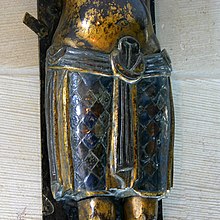Niello

Niello refers to an ornament on silver, more rarely gold, more recently also on copper and bronze, which consists of drawings that are engraved or pressed through steel plates and filled with a kind of black paint. The black paint itself is also called this. Other names are Blachmal , Old High German for "black spot" - based on the sulfurized silver slag - or Tula after the Russian city of Tula .
The Italian word Niello is derived from the Latin nigellus , "blackish". Attaching niello is called niellieren . The maker of niello works is called a nielder or nielder .
technology
Cellini prescribes 1 ounce of silver, 2 ounces of copper and 3 ounces of lead for the black mass , the older Theophilus 4/7 silver, 2/7 copper, 1/7 lead. The amount of sulfur is not specified precisely. According to Pliny , the Egyptians are said to have made this mass from silver and sulfur in equal parts and 1/3 copper.
These components must be repeatedly melted together until the black mass, which disintegrates into small spheres on cooling, shows a uniform structure. Then it is crushed and the metal to be nielloed, which has been moistened by water with a little borax , is completely covered with it. The niello is now melted over glowing coals, but after cooling it is scraped away so that only the recessed areas of the plate remain filled with it. Finally the whole thing is sanded down and polished. As a result, the areas filled in black form a contrast to the shiny metal surfaces. Galvanoplastic niello is created by covering the metal objects with an etching base, engraving the latter drawings and deepening them with etching. The object is then placed in the electroforming apparatus until the lines are filled with the deposited copper, the etching base is washed off and the surface is sanded and polished.
The powder is ready to buy in specialist shops today. Another possibility of the process: the powder is mixed with ammonia or high percentage alcohol to a fine paste (water would start to boil when heated and the mixture would be thrown out of the recess). This is inserted into the indentations with a spatula, the metal is heated with a soft flame, and finally the niello is melted with a pointed flame. The small lead balls on the surface can be drawn with a sharp needle. When the workpiece has cooled down, the niello can be filed flat; it must be noted that due to the lead content, the filing must not be mixed with precious metal filing, and a separate tool should also be used.
history
The Niellotechnik was already known in ancient Egypt and ancient Greece. Already in the grave of Pharaoh Ahhotep (1580-1540 BC) a breast ornament, an ax and a dagger in the niello technique were found, as well as in Mycenaean shaft graves from approx. 1600 BC. The niello was particularly popular in the Middle Ages, outstanding examples are the Tassilo chalice and the Paderborn portable altar by Roger von Helmarshausen . An excellent master of the early Renaissance was Finiguerra in Florence around 1450.
Around 1885–1889, the Niello work had its headquarters in Russia. The best known were the silver tobacco boxes made in Tula , but excellent work was also made in Vologda and Ustjug Veliki. The niello is particularly used for filling in black the digits and tick marks of the minute circle on metal clock faces and for enamelling gold watch cases.
Niello print
As Niellen or Nielli (singular NIELLO ) is also referred to prints on paper or other carriers, which resulted from the imprint of engraved on the type of niello plates. This is a gravure printing process . The indentations engraved in the plate are not filled with the niello paste, but rather coated with paint, thus producing a reversed image of the engraved areas when printed on paper.
Since the medieval goldsmiths presumably took impressions of their niello engravings in this way in order to be able to store and transfer the patterns, the niello prints were associated with the prehistory of the art of copperplate engraving . However, critics consider the niels kept in various collections of copper engravings to be later impressions of copper plates. According to Walter Koschatzky , the Niello print is not to be regarded as a forerunner of the copperplate engraving, as none of the surviving Niello prints can be dated before the emergence of the copperplate engraving and many copies are forgeries from the 19th century.
literature
- Hans-Dieter Dobler, Werner Doll, Ulrich Fischer - metal technology. Basic education , European reference book series for metal professions from Europa-Lehrmittel, January 2007, ISBN 3-8085-1111-7
- Erhard Brepohl - Theory and Practice of the Goldsmith , Hanser Fachbuchverlag, 2003, ISBN 3-343-00004-3
- Antje Bosselmann: Niello, in: Reallexikon zur Byzantinischen Kunst , Stuttgart, founded by Klaus Wessel and Marcell Restle , with the assistance of Birgitt Borkopp, Barbara Schellewald, Thomas Steppan, Lioba Theis , Vol. 7, Stuttgart 2004, Sp. 966-976
Web links
Individual evidence
- ↑ Niello. In: Duden online , accessed on April 1, 2017.
- ↑ Niellieren. In: Duden online, accessed on April 1, 2017.
- ↑ Jochem Wolters: Niello in the Middle Ages . In: Uta Lindgren (Ed.): European technology in the Middle Ages . 3. Edition. Gebr. Mann Verlag, Berlin 1998, p. 169-186 .
- ↑ This is what the Italian art writer of the Renaissance, Giorgio Vasari , asserts . Niello , in: Lexikon der Kunst , Volume V, EA Seemann Verlag, Leipzig 2nd A. 2004 (first 1993), p. 185.
- ^ Walter Koschatzky: The art of graphics. Technology, history, masterpieces . Dtv, Munich 1999, pp. 102-3.